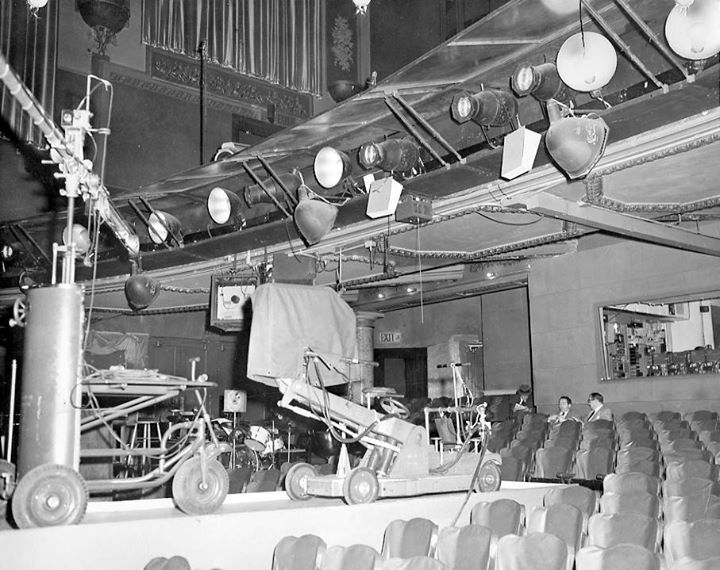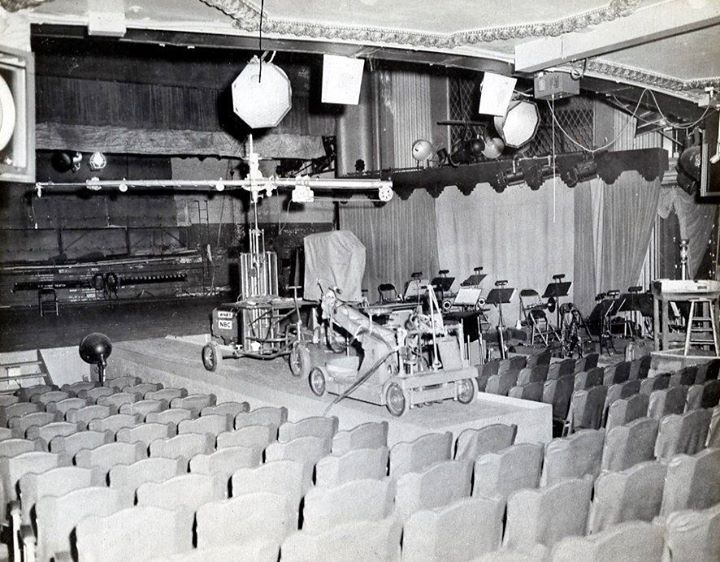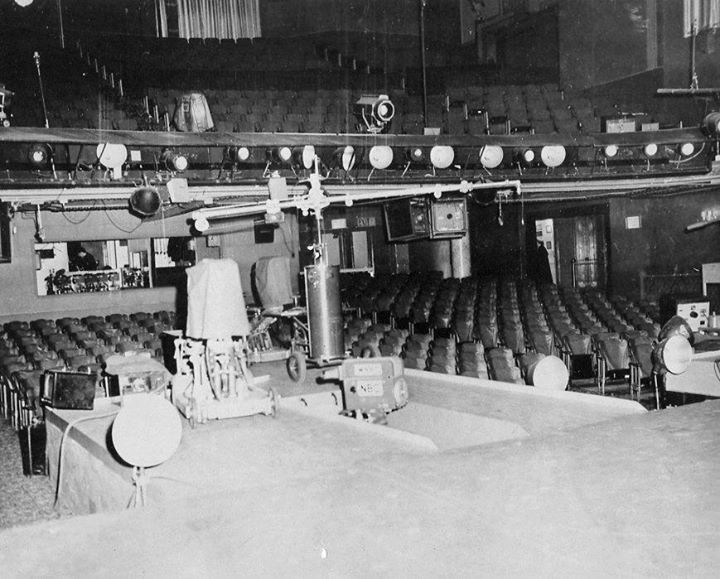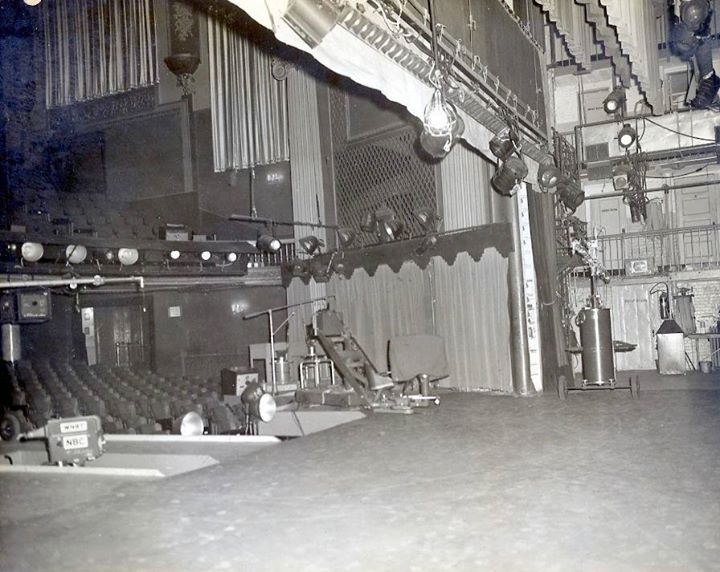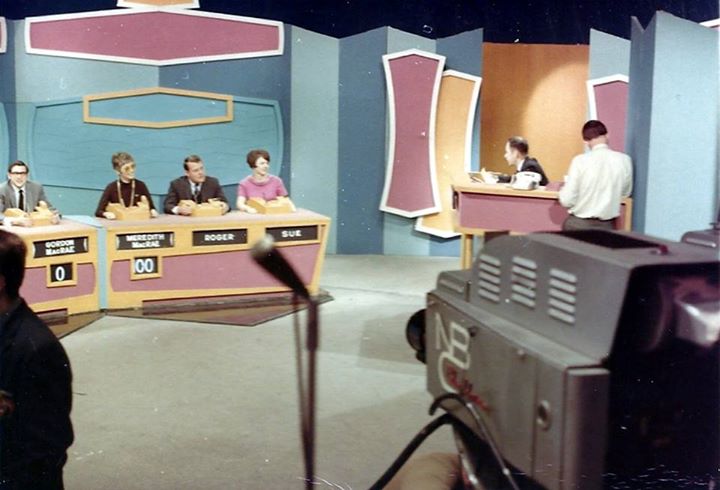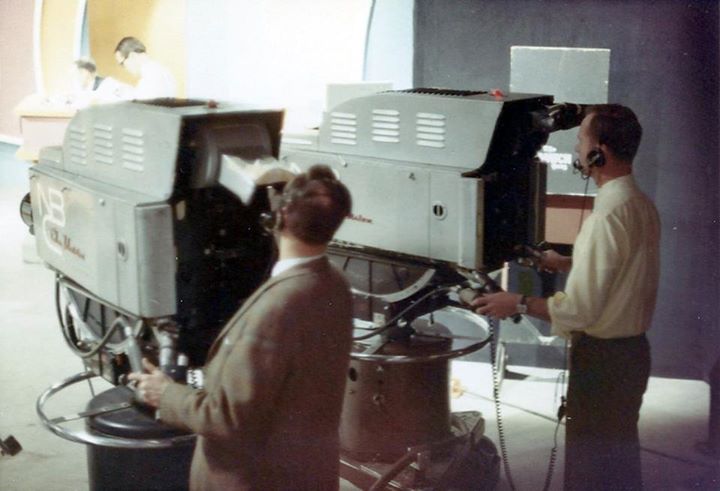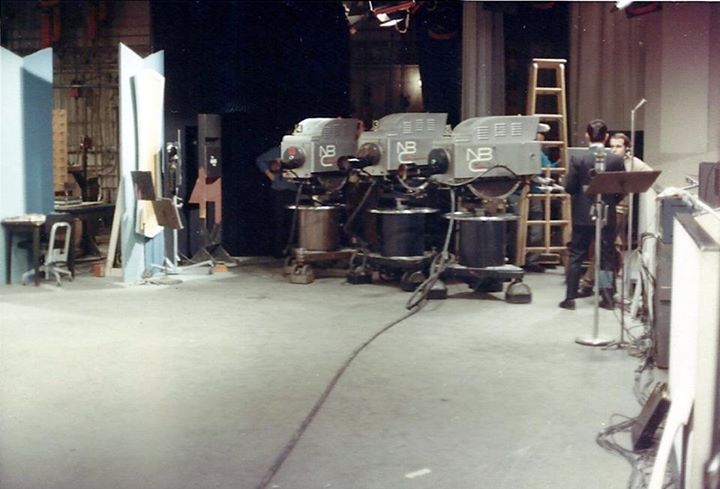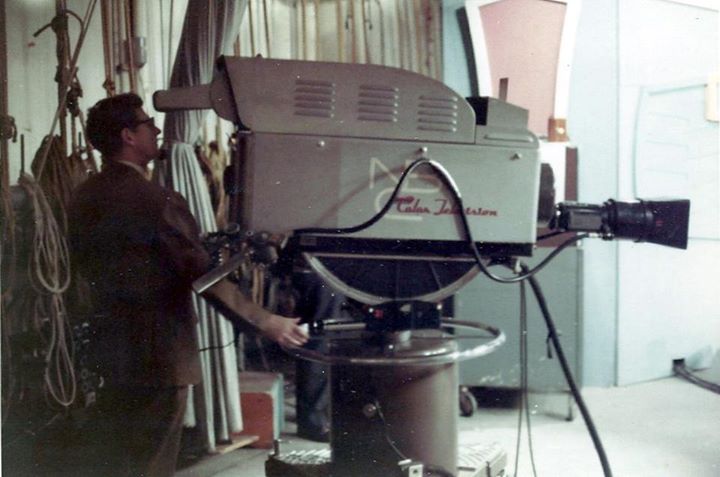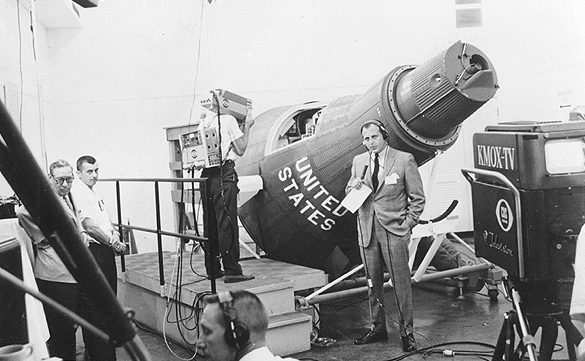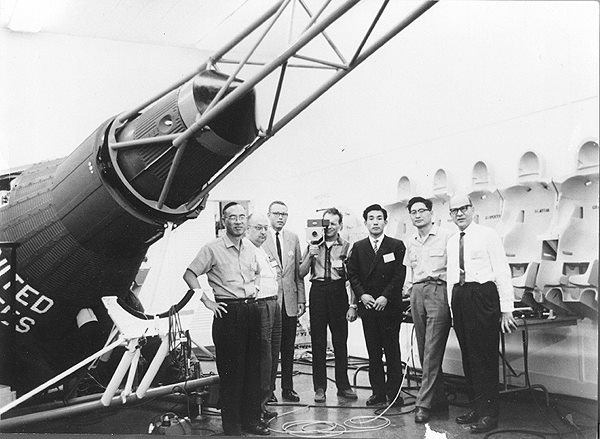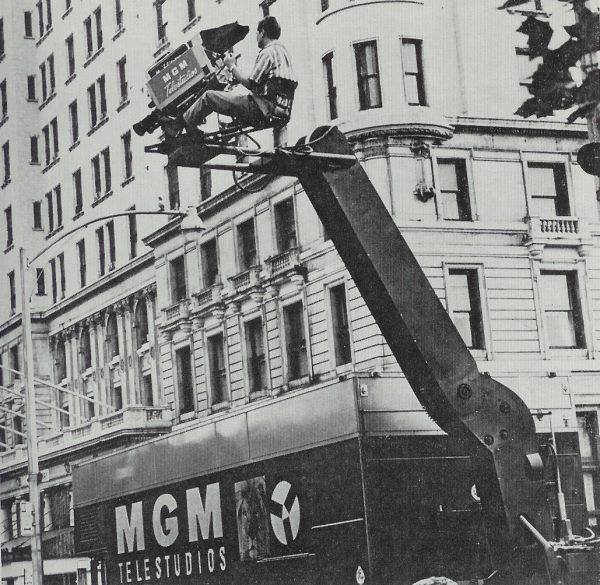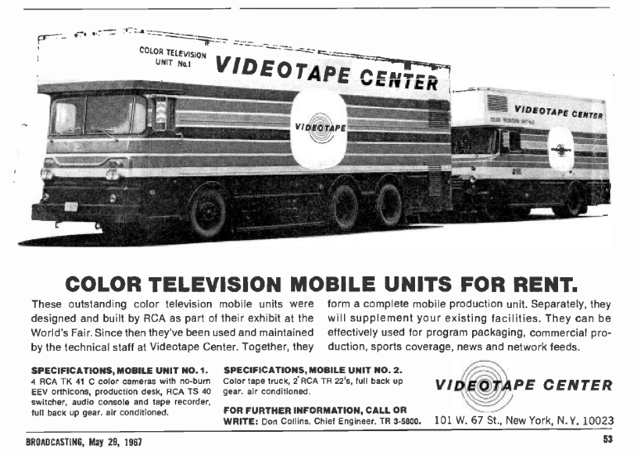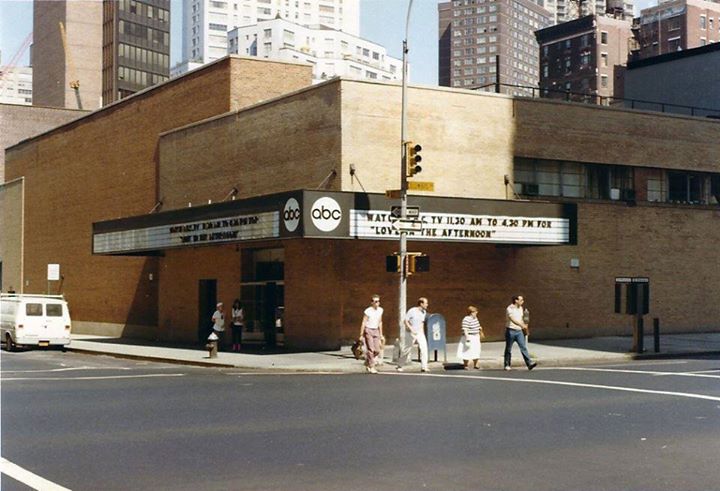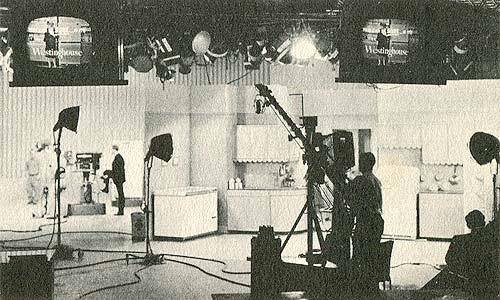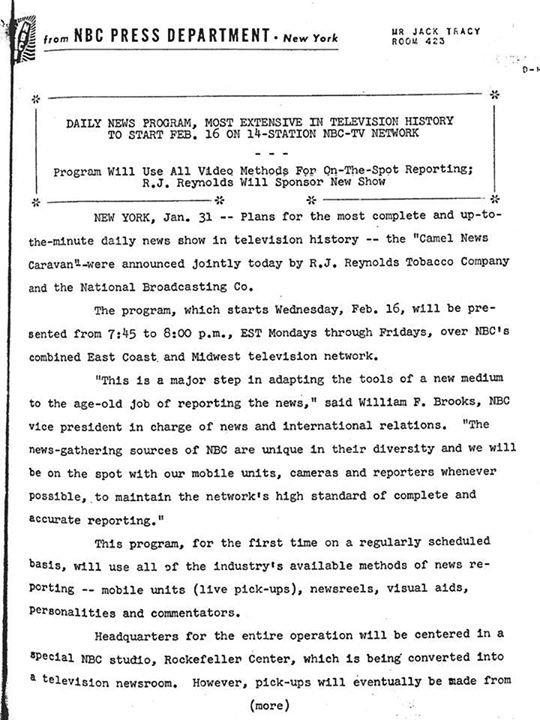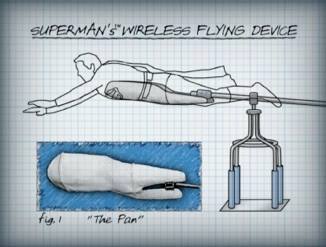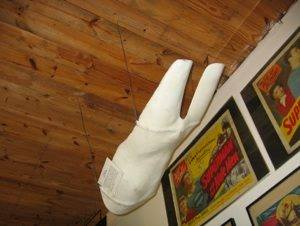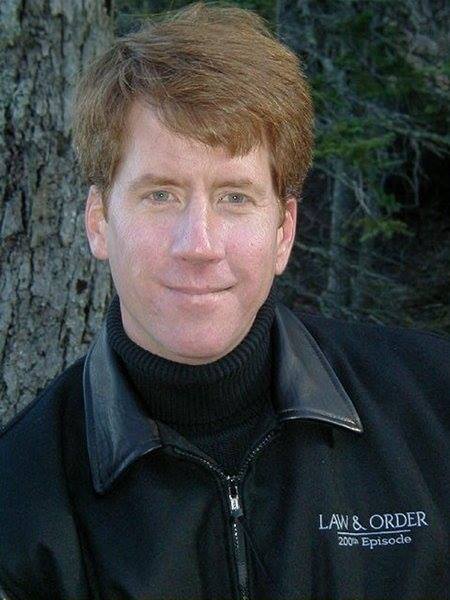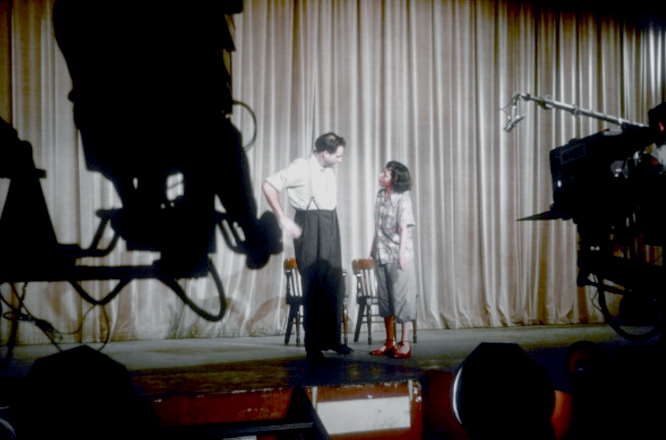
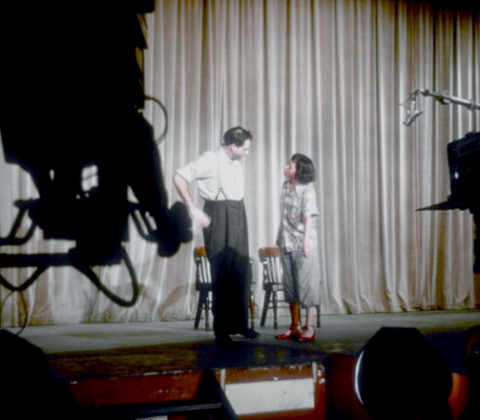
February 25, 1950…”Your Show Of Shows” Debuts On NBC!
February 25, 1950…”Your Show Of Shows” Debuts On NBC!
To really appreciate the historical importance of “Your Show Of Shows” in television history, just remember…this is the format that “Saturday Night Live” is built on, it was the first “participating sponsor” show, and a program that lead launched several of the industry’s top comedy creators, like Mel Brooks, Carl Reiner, Woody Allan and more.
To get the whole story, there is no one more qualified than the show’s star, Sid Caesar to tell it, and here he is. By the way, in the eight minutes just before my starting point on the Emmy TV Legends video, he talks about the “Admiral Broadway Revue”, Pat Weaver, and having to wait for the cameras to arrive from a baseball game. Really. https://youtu.be/JtSpZ8iD80I?t=8m57s
“YSOS” debuted as part of a two and a half hour live block that was called “Saturday Night Review.” The first hour, was “The Jack Carter Show,” done at NBC’s WMAQ studios in Chicago and was a comedy and variety affair airing at 8 Eastern. Included here is a photo from Carter’s show with a very young Jerry Lewis and Dean Martin on each side of Carter.
At 9, ninety minutes of fun on YSOS hit the air live and was followed at 10:30 by “Your Hit Parade”. Jack Carter’s show was replaced the next year by “The All Star Review.” This two and a half hour block was the first time Pat Weaver’s “participating sponsor” plan was used, which gave us the now famous phrase; “Brought to you in part by _____,”
The show debuted from NBC’s first television converted theater, The International at 5 Columbus Circle. When NBC first began to use the theater with the “Admiral Broadway Revue” show, it was a three camera show done with a mobile unit feeding the show back to 30 Rock on an AT&T line. By the time YSOS debuted, NBC had installed a control room and four permanent RCA TK30 camera chains.
Speaking of the 1949 Admiral show, did you know it was so popular, it was canceled!?!? What? It’s true!
“The Admiral Broadway Revue” was the start of one of television’s greatest early comedy teams…Sid Caesar and Imogene Coca, with the great Max Liebman producing. The show had great ratings but unbelievably, Admiral (who “owned” the show) ended it in June of ’49 after only five months on the air. It seems that the show generated sales of Admiral TV sets that were so far beyond their capacity to manufacture them, Admiral had to either end the show or build a new plant.
Since they owned the show, it could not continue with another sponsor and they would not sell it. Such were the sponsorship problems of the early days of television. Soon after this, NBC Vice President Pat Weaver would solve this problem by having the network own the shows and sell spots to sponsors. He is the man that brought magazine style ad sales to radio and television, which spread the cost of production among several advertisers, and gave the networks ownership.
On February 25, 1950, four of The International’s brightest years started with the debut of “Your Show Of Shows,” Caesar and Coca were back with a cast of writers that have become the “who’s who” of comedy including Mel Brooks, Neil Simon, Danny Simon, Mel Tolkin, Lucille Kallen, Selma Diamond, Joseph Stein, Michael Stewart, Tony Webster, Woody Allan and Carl Reiner.
Below is a classic clips from “Your Show Of Shows” with Carl Reiner and Howard Morris in with Sid and Imogene, as “The Haircuts” in a song parody sketch.
Also induced here are exclusive photos inside The International Theater showing the YSOS stage, layout and equipment in 1951. There were four cameras in use with one on a Houston Fearless Panoram dolly and one on the newly developed Saner crane that you see here. Add two two sound booms and two pedestal cameras and you have a stage full of equipment to set scenes around.
With commercial sets only :70 seconds long, full set changes had to be made quickly and at times, there was no commercial break between sketches, which is why on the left side of the stage you see a “limbo set”, which is a back drop on the wings that can be used for live commercials or short sketches that give the crew time to make a scene change on the main stage. The 25 piece orchastra was on the other side, stage left, as was the customary location of bands in television. NOTE: The Sanner Studio Crane on this stage was the first crane ever used in television!
Finally, we have the New York Times ad for the show’s debut and an ultra rare copy of the debut shows Saturday schedule, that shows the final rehearsals for each sketch on that nights show.
Enjoy, and please share this! -Bobby Ellerbee
Above and below is the Sanner Studio Crane…the first ever TV crane
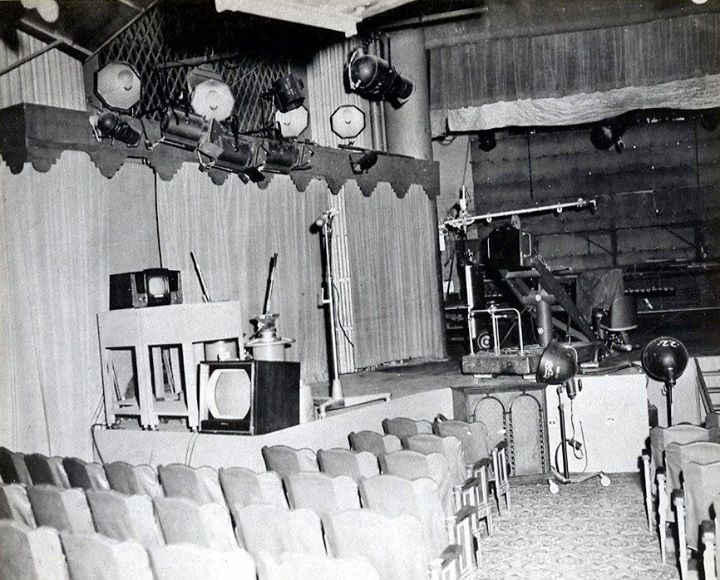
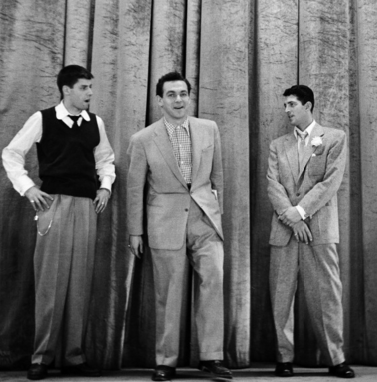
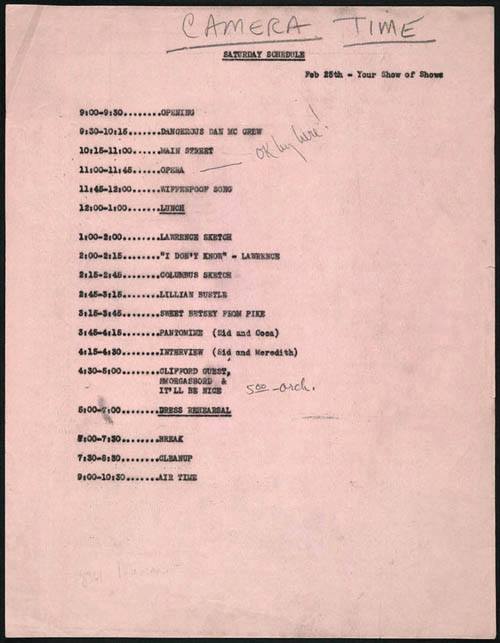
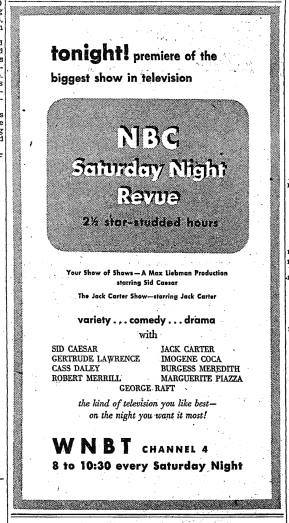
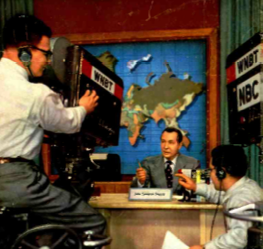

Behind The Scenes At “The Camel News Caravan”, 1953
Behind The Scenes At “The Camel News Caravan”, 1953
This month, we’ve done several stories on the history of the early TV news shows, and I thought this would be a nice compliment to all that we’ve seen. This is a short but sweet article on how John Cameron Swayze’s show was done by his director, Ralph Peterson.
Notice that their location is in the NBC Uptown Studios at 106th Street, at the Pathe complex. In this Emmy Legends video clip, former NBC News president Ruven Frank, who is listed in the article as the show’s Chief Writer at the time, describes how the Caravan film operations worked. https://youtu.be/80_Pv9Aizsg?t=15m21s
Behind the scenes of John Cameron Swayze’s “Camel News Caravan” is where this article from 1953 takes us!
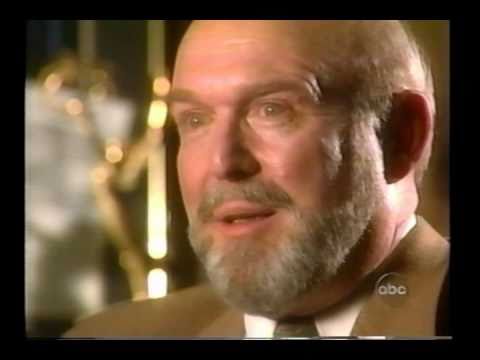
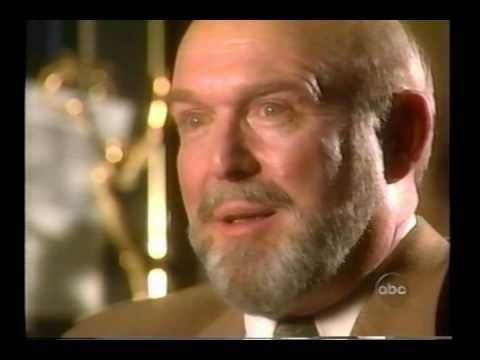
“The Agony Of Defeat”…The Story Behind TV Sports Most Famous Line
“The Agony Of Defeat”…The Story Behind TV Sports Most Famous Line
Brent Musburger takes us to Oberstdorf, Germany and the 1970 ski jumping competition where this all got started. There, Vinko Bogataj, the former Yugoslavian skier, became a part of sports history and here’s the whole story of the man that put “the agony” in defeat. There are some surprises here too!
Although the clips in the “Wide World Of Sports” intro changed over their 37 year run, the copy read by Jim McKay was the same as it was when the show started on April 29, 1961. The Saturday afternoon tradition came to an end January 3, 1998.
“Spanning the globe, to bring you the constant variety of sports…the thrill of victory…and the agony of defeat…the human drama of athletic competition…this is ABC’s Wide World of Sports!”
Another look at the story of Vinko Bogataj, the former Yugoslavian (Slovenian) ski jumper who became infamous as the man in ‘Agony of Defeat’, in the opening…
Source
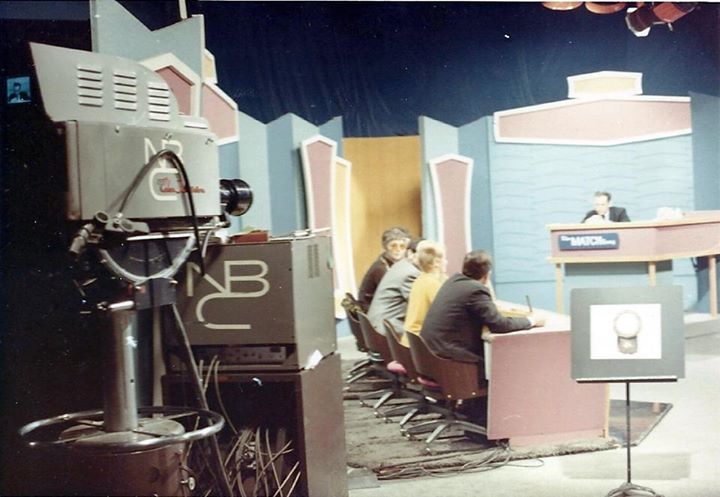
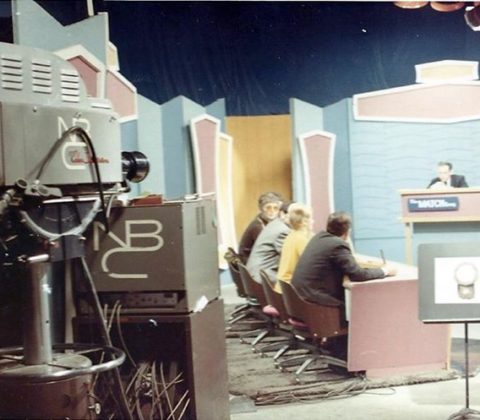
Exclusive “Match Game” Photos In NBC Studio 8H
NBC cameraman Bob Batche took these photos in Studio 8H in December of 1968. Notice in three of these shots, taken during rehearsal (yes, there was a rehearsal with fake questions) the man behind the host’s lectern is not Gene Rayburn. It is our friend Dick DeBartelo, the man who wrote the questions and thousands of articles for “Mad Magazine”.
The show started on New Year’s Eve of 1962 in black and white. Planning for 8H’s colorization started in the spring of 1963. When the network’s 62-63 season had concluded, the physical work began and four RCA TK41 color cameras were moved from The Ziegfeld Theater to 8H. The studio went color on June 24, 1963, and “The Match Game” was among the first color productions from 8H. I think they taped five shows each Tuesday. The last episode to air on NBC was September 24, 1969.
In the summer of 1973, “The Match Game” came back to life on CBS at Television City’s Studio 33, and was a hit all over again. The 1,439th and final CBS episode aired on April 20, 1979.
The show is back on ABC now with Alec Baldwin as host and executive producer. I’m not sure if Dick DeBartolo is writing the questions for the new show, but even if he’s not, he gave us plenty to laugh our _____ off, on the NBC and CBS versions! -Bobby Ellerbee
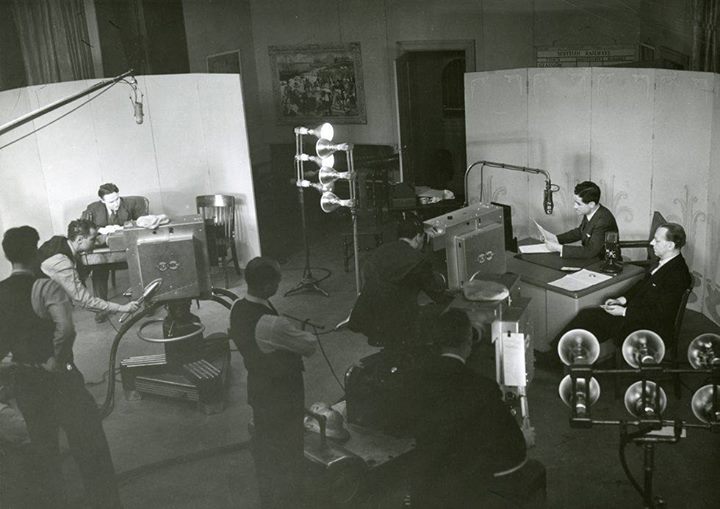
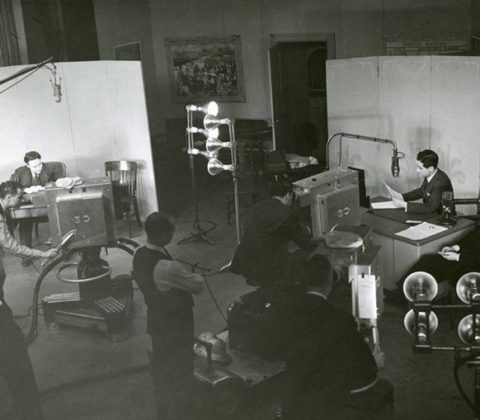
February 21, 1940…TV’s First Regularly Scheduled News Debuts
February 21, 1940…TV’s First Regularly Scheduled News Debuts
In a new area, where no one has ever been before, there are many “firsts”, and that applies to television too, but in TV’s case that has to be broken into two parts; the experimental-pre war period and the commercial-post war period.
This event, television’s first regularly scheduled news cast falls into the experimental-pre war period, where on this day in 1940, “Sunoco News With Lowell Thomas” debuted on W2XBS, NBC’s New York station.
In truth, the fifteen minute show done from NBC’s Studio 3H, was a simulcast of his NBC Radio show. It was broadcast only on Wednesdays at 6:45, as this was the day his radio show presented the daily news, plus a weekly summary of the news. Thomas had done a few TV newscasts in 1939 during the World’s Fair as part of RCA’s big effort to introduce the public to television. Even CBS’s W2XAB had tried a few local news casts with Richard Hubble as host.
No one is sure how long this Sunoco News show lasted, as some accounts have it ending in March and some say it ended in June, just before Thomas anchored the first live telecast of a political convention, the 1940 Republican National Convention, which was fed from Philadelphia to W2XBS in New York and on to W2XB in Schenectady.
It seems that the second regularly scheduled news show on NBC was the live, weekly “Esso Television Reporter” from March until May of 1940 hosted by William Spargrove, who narrated off camera. The live Esso program used organ music and on camera was a mix of newswire photos, maps and graphic miniature depictions of news event locations, as on-the-scene film reports were nearly impossible to get because no one had TV news departments.
In 1940, America was not involved in WW II yet, but Europe had been fully engulfed since 1938. As we will see, the war severely curtailed television in every way, but now we move to the commercial era.
Eight days before the July 1, 1941 conversion of W2XBS to WNBT and W2XAB to WCBW, Hitler began Operation Barbarossa which was Germany’s invasion of Russia.
On July 1, 1941, NBC’s first day of commercial broadcasting, from 2 till 5 they broadcast the Dodgers and Phillies baseball game sponsored by Bulova. At 6:45, “Lowell Thomas With The News” was broadcast and sponsored by Sun Oil (Sunoco).
It is not known how long this 15 minute weekly newscast lasted, but is known that Thomas hated being tied to a television studio. He was well known for globe trotting with his radio show, and often did the newscasts from his home, so I suspect it did not last long, which brings us the the next NBC pre war news show.
From July of 1941 till May of 1942, Sam Cuff hosted a weekly news commentary called “Face The War”, but the show ended as RCA and NBC cut television operations down to next to nothing five months after Pearl Harbor. The same was true at CBS.
On February 21, 1944, things started to stir a bit as “The War As It Happens” came to television on a weekly basis, and NBC News has been on the air more-or-less continuously since then.
The photo here shows Thomas in NBC Studio 3H in 1940. -Bobby Ellerbee
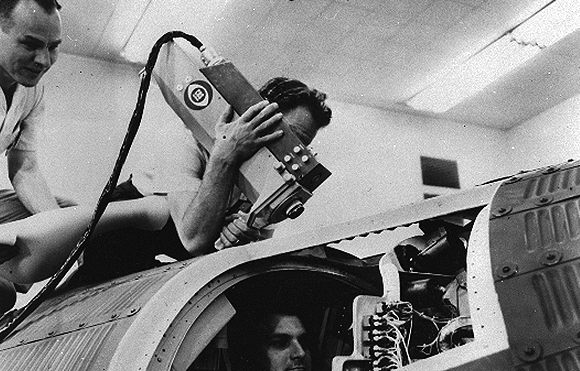
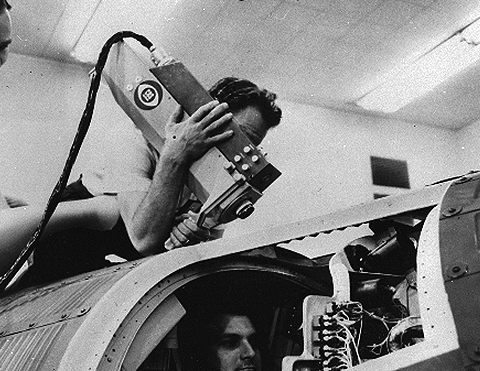
February 20, 1962…Glenn Orbits Earth, CBS Debuts Mini Camera
February 20, 1962…Glenn Orbits Earth, CBS Debuts Mini Camera
On this day in 1962, John Glenn became the first American to orbit the earth. His flight in Friendship 7 was NASA’s third manned space flight, but their first to take a man into earth orbit, as the first two had been suborbital.
Ten months earlier, Russian cosmonaut Yuri Gagarin had become the first man to orbit earth, and there was indeed a “space race” with the US lagging behind. Catching up and surpassing Russia was a matter of national pride.
In much the same way, there was a tech race between CBS and RCA. CBS was lagging RCA’s NBC in technology. but catching up and surpassing them was a matter of network pride. The color wars between the two a few years earlier had left blood on the walls and CBS hated to have to buy equipment from RCA. When the did, they took all the RCA markings off, which brings us to their mini camera development work with Ikegami.
RCA had introduced the “Walkie Lookie” hand held vidicon camera in 1952 and it got used at political conventions and once or twice was used on the sidelines of a football game in the mid ’50s. That I know of, CBS never bought any of these, but over time they discovered their need for a light portable camera.
In 1957, CBS used portable vidicon back pack cameras (like the RCA version) made by CSF Electronics in France. By 1960, the RCA TK60 and Marconi Mark IV cameras were coming on line with a bigger and sharper black and white picture from the new 4 1/2″ Image Orthicon tube. CBS wanted a portable that used and IO tube, and not a vidicon tube.
Dr. Joe Flaherty was a CBS VP of Technology around this time and was traveling to Japan and Europe looking for new ideas. At the BBC, he discovered they were testing what would eventually be the Norelco PC 60 color camera…a life changer for CBS.
In Japan, he became acquainted with a small electronics company called Ikegami that was working on a portable camera. One thing lead to another and by late 1961, they had built a prototype based on CBS specifications. In early ’62, Ikegami sent two engineers (seen below in the last image) and the CBS prototype cameras to the US for field testing.
That camera was used for coverage of Friendship 7, at the McDonald-Douglas plant in St. Louis where the capsule was built. There, they used the camera to shoot the interior of a Mercury capsule as the operator inside demonstrates what Glenn was doing as he orbited. The St. Louis pictures were folded into the hours of narration from Walter Cronkite and his colleagues as the flight progressed.
If you remember Walter’s “Go baby go” remark from the launch, here is his remembrance of that remark and the occasion. Enjoy and share. -Bobby Ellerbee
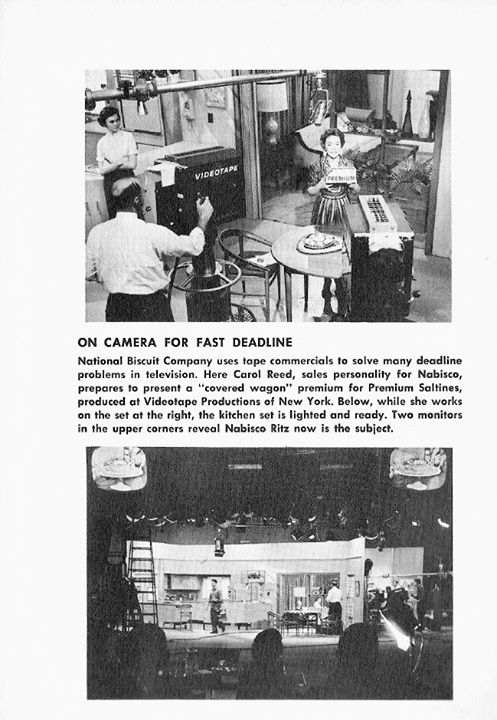

The History Of The Ampex Owned…Video Tape Center, Part 1 of 3
The History Of The Ampex Owned…Video Tape Center, Part 1 of 3
America’s First Commercial Television Production Facility
In 2014, our friend Tom Coughlin traveled to Minnesota to comb the 3M archives as part of his ongoing research into the history of America’s first, and most innovative commercial tele production facility. Tom is a professor of journalism, but his deep interest here is also personal, as his dad was a longtime staff member at Videotape Center as well. This is part one of three fascinating instalments. Enjoy and share! Bobby Ellerbee
By the way…if you have Videotape Center photos…please send or post them here as they are quite rare.
______________________________________________________
The rise and fall of Video Tape Center – Tom Coughlin
Videotape Productions of New York (a California company), was initially founded as a wholly-owned subsidiary of the Ampex Corporation in 1958 by Ampex and Howard S. Meighan, who served as the company’s first president. Meighan had started his career in the 1920s at J. Walter Thompson, and had worked at CBS for 24 years. For a time, he served as the president of CBS Radio, and Vice President of West Coast Operations where he was in charge of the development of Television City. An early advocate of Ampex videotape technology, he was responsible for CBS’s purchase of Ampex’s first production videotape machines in 1957. After leaving CBS, he was eager to start his own firm, and his reputation and experience as both an advertising executive, and a builder of broadcast facilities made him well-qualified for starting New York’s first independent videotape production house. http://www.nytimes.com/1995/03/14/obituaries/howard-s-meighan-dies-at-88-led-in-using-videotape-on-tv.html
Almost immediately, the 3M company stepped in and acquired half of Ampex’s shares, making Videotape a joint venture between the 3M Company and Ampex…the two giants of video tape technology.
The initial corporate board of directors for Videotape Productions was composed of six representatives– three from Ampex of which Meighan was the president and chief operating officer, and three directors appointed by 3M. John B. Lanigan, one of 3M’s directors, who had served as the eastern sales manager for NBC-TV and an account supervisor for Compton Advertising, took the role of vice president and was actively involved in acquiring the initial studio. Years later, he retold the story of the starting of the company to later members of the Videotape board, which was captured for posterity in the meeting minutes, and are cited here.
Lanigan recalled that in 1958 they needed to find a working studio in New York City that they could lease–and fast. They were hoping to rent a fully built-out existing facility in order to start into the venture quickly, and reasoned that since the introduction of television video recording, there would be a reduction in the need for studios for network TV use, and if they looked around, they’d find something.
The first lease opportunity was from Metropolitan Broadcasting Company (previously known as Dumont Television, and later known as Metromedia Television), where they had negotiated to rent Studio 1 and 5 at the studio center at 205 E. 67th St., however at the last minute, they lost their bid when CBS offered a three-year lease for those two studios at a higher price than what Videotape was offering. Metropolitan offered them Studio 4 as a consolation prize, which Videotape declined. (CBS referred internally to these two stages as Studio 63 and 64, “Sargent Bilko” was filmed there, along with the videotaping of the serial “Edge of Night”.)
While visiting NBC, they toured the studio complex at 101 W. 67th Street, which Lanigan thought was perfect, and he made an offer to NBC to lease the facility, but NBC wasn’t interested (though three years later, NBC relented, and leased them the facility, which became Videotape Productions’ “Videotape Center” (1961-1970). At the time NBC was using the facility for the “Home” show with Arline Francis.
Instead, NBC offered two alternatives—The Colonial Theater, a former RKO movie theater at Broadway and 63rd St. that NBC had used since 1952 as their first color broadcast center, and The New Century Theater at W. 58th St. and 7th Ave., which the Videotape Productions board decided to rent temporarily until more suitable space could be found (or in this case, they subleased–the theater building was owned by the Schubert Organization, and under long-term lease to NBC who provided it fully-equipped, except for the lighting dimmer board–Videotape had to purchase one and install it). The facility featured a single stage with a large audience area–not an ideal setup for the recording of TV commercials on videotape, but adequate for a growing start-up company.
Commercials taped in the New Century Theater include spots for Armstrong Cork, Schaeffer Beer, Studebaker-Packard. Coates and Clark, General Mills, Vicks, Rheingold Beer, and Smith-Corona Typewriters.
In 1959, Videotape Center became the first North American studio to install three Marconi Mark IV black and white TV cameras. The cameras were featured in a public demonstration hosted by parent company Ampex (North American distributor for Marconi) on September 30. Videotape was able to get their camera chains into production in time to produce a commercial that aired on ABC on November 23. (“Broadcasting”, October 5, 1959, p 34)
In February 1961, CBS Productions, the in-house commercial film/video production unit of the CBS network was closed down, which provided Videotape a chance to hire their three producers, and potentially gain their accounts (industrial productions mostly) that CBS decided to shed. (“Broadcasting”, February 6, 1961, p 71)
In 1961, NBC offered Videotape the opportunity to move into 101 W. 67 St., which no doubt delighted them. Unlike the Century Theater, the West 67th St studio was built from the ground up as a television facility. Initially built by the Robert Gless Co. in 1951 for The Bamberger Broadcasting Service (a division of the Macy’s department store chain that owned WOR Radio, WOR-TV Channel 9, and was a flagship station of the Mutual Network), the building itself was owned by the Macy’s employee pension fund, and it had been leased prior to completion to Thomas S. Lee Enterprises (a company that was later absorbed into RKO General—Lee, the son of the broadcasting pioneer Don Lee, owned several Mutual Network stations on the West Coast, and held a 25-year lease on the building running January 1952 to January 1977).
Soon after the building was completed in 1952, Macy’s sold their broadcasting division to the RKO General Corporation, and after a transitional period, WOR relocated their TV operations to their headquarters at 1440 Broadway and to a new compact studio facility at the Empire State Building. In early 1954, RKO sublet the 67th St. facility (both building and TV equipment) to NBC for three years with options for extensions. (“Broadcasting and Telecasting”, January 18, 1954, p60)
Aware that they were entering into a sublet situation prior to moving in, the Videotape Productions corporate board was careful to arrange a separate agreement with RKO General, so that they would be automatically offered a lease from RKO after NBC’s lease ran out in 1963. The RKO deal guarantied lease renewals to 1975, however it stipulated that RKO required three year’s advanced notice in the event that Videotape wanted to terminate the lease. There was major advanced preparation at the three-stage studio facility over the summer of 1961, and the final move took place in September.
“The Television Plant Memorandum” between NBC and Videotape Productions describes in detail how the transfer of NBC-owned studio equipment between the various studios was to be conducted. The three control rooms at 67th St. (67-A, 67-B and 67-C) were to remain unchanged, except for the removal of turntables and sound effects equipment (which were sent to studios 3-A and 3-C in Rockefeller Center). An effects amplifier in Studio C, a Tektronix 524 oscilloscope and a Conrac monitor were retained by NBC, along with all of the loose tubes, and the image orthicon tubes that NBC had been using in cameras owned by WOR. Several recently-installed NBC-owned RCA TK-12 cameras, and a color camera that was used for chroma key were removed, along with their pedestals. Other NBC equipment that was removed included mic booms, Houston cranes and floor monitors.
Videotape Productions traded to NBC the lighting dimmer board from the New Century theater for three older boards that NBC had installed at 67th St. (A peculiar quirk of the NBC lighting installation at Videotape Center was that while Studio A was the largest of the three studios, Studios B and C had larger dimmer boards and more power available for lighting use.) NBC left for Videotape much of the equipment that had been installed prior to 1954 by WOR—one Houston Fearless Panoram Dolly, six camera pedestals, eight camera chains, four Mole Richardson mic booms, eight sets of Ektar 50 mm, 90 mm and 135 mm prime TV lenses, four Ilex 8 1/2” long lenses. Lighting equipment remaining included 40 scoops and six strip lights.
Almost immediately after the move, the company reached the conclusion that the facility was too small their operation, so in 1962 the board contacted Charles Luckman, the architect for CBS’s NY Broadcast Center, to evaluate the site. Luckman concluded that a third floor could be added for between $750 and $900 thousand, which the board of directors thought would be a good investment for the landlord (considering the re-gentrification going on in the Lincoln Center neighborhood at the time), but it was an expensive improvement for tenants to undertake. The company made do with their perennial office space shortage by moving many members of the non-production support staff out of the building. End of part one.
Below is a page from a magazine article that shows what I think is the 67th street location. The cameras are the NBC TK30s which NBC inherited from WOR. VTC was the first in the US to use the Marconi Mark IV cameras…I used to have photos of them but don’t have them anymore. Does anyone have any VTC Marconi photos?
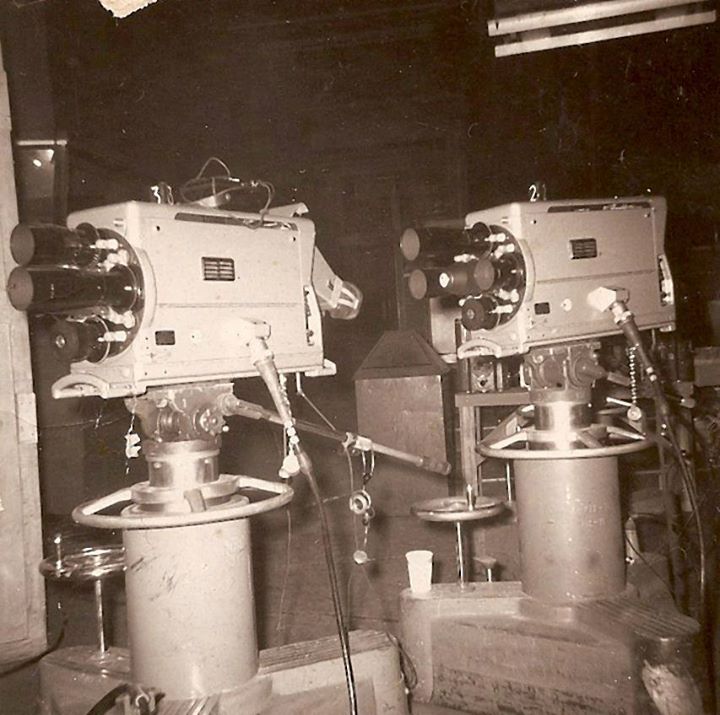
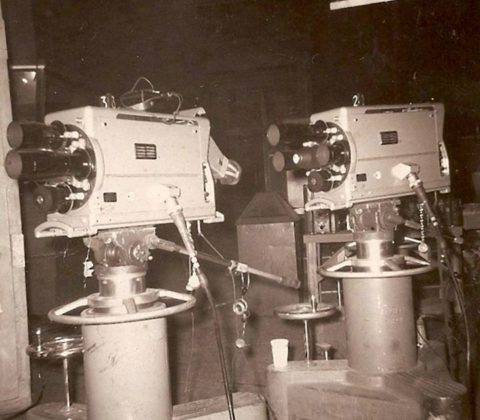
The History Of The Ampex Owned…Video Tape Center, Part 2 of 3
The History Of The Ampex Owned…Video Tape Center, Part 2 of 3
America’s First Commercial Television Production Facility
A few years ago, our friend Tom Coughlin traveled to Minnesota to comb the 3M archives as part of his ongoing research into the history of America’s first, and most innovative commercial tele production facility. Tom is a professor of journalism, but his deep interest here is also personal, as his dad was a longtime staff member at Videotape Center as well. This is part one of three fascinating instalments. Enjoy and share! Bobby Ellerbee
______________________________________________________
The 1962-1963 time period featured a busy schedule of TV commercials, a pilot for David Susskind (a series of one-hour adaptations of Broadway shows) that didn’t advance into series production, also production of Susskind’s “Open End” series for the 1963-4 season. For Sonny Fox Productions, Videotape Center recorded the TV adaptation of the off-Broadway show “Cowboy and the Tiger”, which aired on ABC in November 1963. Here is a clip of that show which was shot with Marconi Mark IV cameras. https://www.youtube.com/watch?v=hpZKrpuo8nM
In 1964, Videotape Productions demonstrated its “Edimation System”—a customized integration of Ampex’s “Editec” and “Edicomp” devices, which permitted time lapse video for the first time. These devices were demonstrated in advance of Ampex’s new product announcement. (“Broadcasting”, February 17, 1964, p 62)
In early 1964, Ampex Corporation left the partnership by selling their shares to 3-M, making it the sole owner. Howard S. Meighan, who was an Ampex board appointee and who also held a minority share of the company, took this opportunity to retire from the company presidency, and was replaced by Lanigan (“Broadcasting”, June 8 1964, p 10).
Business was no doubt adversely affected by the departure of Meighan, who was well connected to network executives and ad agency people, and after a year of poor revenues, 3-M concluded the 1965 calendar year, by reselling the shares formerly owned by Ampex, to M-G-M, which consolidated it’s New York City-based tape production house (M-G-M Telestudios) into Videotape Center using a shared assets agreement. Lanigan explained “it was a merger of two non-profitable companies, with the hope that one profitable company would emerge” (board minutes, July 1966). Joining the board as Vice President of the new company, was George K. Gould, the founder of Telestudios, who had lead the company through it’s acquisition by National Telefilm Associates, and then M-G-M in 1961 (“Broadcasting”, November 22, 1965, p 58).
The executive board for the new (post-1965) joint venture consisted of representatives from both 3-M Corporation and M-G-M. This was not a happy marriage–there were several management disagreements between the two groups of representatives. M-G-M’s people were quick to exploit loopholes in lease and labor contracts (which they did with RCA, AFTRA and the IBEW to save money). In addition, 3-M central corporate financial structure was such that they would absorb the bad, uncollectable debts of subsidiary companies—a feature that the M-G-M corporate directors took advantage of repeatedly, to the objections of the 3-M directors.
The joint assets operating plan of Fall 1965 was a blueprint to consolidate two companies’ large investment in soon-to-be obsolete black and white cameras, switchers, and low-band video tape machines. Telestudios was able to sublease their facility at 1481 Broadway (The Rialto Theater) to NBC, who used it to produce the soap opera, “The Doctors”. In 1966 they sold off their six TR-22 recorders (low band) and four of their six black and white RCA TK-60 cameras (the remaining two were leased to NBC for a time, and later used at Videotape Center for shooting titles and slates). In addition, they had four color RCA TK-41c cameras in the studio that were sold; and four Gemini film camera systems for which there was no resale market. The three black and white Marconi Mark IV cameras in Studio A (Ampex had been the US distributor for these English-built cameras) were considered unsalable— 3-M contemplated donating them to a university as a tax write-off. Studios B and C had 1950s-era RCA camera chains owned by RKO (from the early 1950s when WOR operated the studio) which were included the original facility lease from 1961, which were obsolete by that time, and didn’t actually belong to either Videotape Center or M-G-M.
To provide color recording capability at Videotape Center with the lowest possible initial investment (they were concerned about getting the new company heavily invested in color equipment at a time when the technology was rapidly improving), several months prior to the start of the joint operating agreement, M-G-M Telestudios signed a five year lease (November 1964 to November 1969) from RCA for three used TK-41c cameras and two TR-22 recorders, to which 3-M was cosigner and guarantor, to upgrade the Leo remote camera truck and the associated videotape truck to color. After the start of the joint venture, Videotape Center contributed an additional fourth TK-41c to the truck that had been used in the studio for evaluation and chroma key use. (Other than this one camera chain, Videotape Center was a black and white TV studio until Spring 1967.) The ownership of the Leo remote truck and the tape truck (including the TV cameras and video tape machines installed on it) was kept separate from the rest of the Videotape Center joint venture to take advantage of M-G-M’s pre-existing lease agreement with RCA, as well as a pre-existing labor contract with the IBEW that offered more favorable labor costs for the remote truck technicians.
In addition, the joint venture wished to retain 3-M’s more-favorable studio employee contracts with DGA, AFTRA, and IATSE. While the joint venture (which continued to do business under the name Videotape Center—M-G-M’s Leo remote truck was repainted), there were two separate teams of IBEW-represented employees working on the truck and working in the studio with different pay schedules and seniority lists. Between 1966 and 1969, both AFTRA and IBEW had staged strikes at Videotape Center to protest this corporate slight-of-hand, which they viewed as unfair labor practice. (The labor problems at Videotape Center resulted in an ongoing disagreement between 3-M and M-G-M corporate directors, and contributed in no small way to 3-M’s eventual decision to liquidate the joint venture.)
By all accounts the Leo truck was pretty busy. ABC rented it from January to May 1966 (and while doing so, offered to buy it), and CBS rented it for $2,500 a week between September and December 1966. In addition, CBS frequently rented the videotape truck (which contained two RCA TR-22 video recorders) for stand-alone use.
The Videotape Center engineering department was never entirely pleased with the performance of the used RCA TK-41c cameras—they produced noisy pictures compared to plumbicon cameras, and while they were acceptable for TV show origination, they were not up-to-date enough for TV commercial work. Videotape Center’s upgrade plans from 1965 included decommissioning Studio C, and purchasing eight cameras, four each for Studio A and B. (The upgrade plans called for getting six cameras in early 1967, and an additional two in 1968) and they had evaluated the Marconi Mark VII, Norelco PC-70 and RCA TK-42 cameras before deciding to go with Norelecos.
The main reason they chose to buy eight Norelco plumbicon cameras over the other makes was the price: Norelco PC-70s were selling at $65,000 while the Marconi Mark VII and TK-42 were both $80,000. In addition, Norelco was willing to give Videotape a delivery date for six cameras in Spring 1967, while Marconi wouldn’t be able to deliver until Fall 1967.
There were technical considerations too. Comparing the Norelco PC-70 color picture to that of the TK-41c, the picture quality was softer and more pastel-like, though the 41c rendered red shades more accurately. The TK-41c had a tendency toward grainy, noisy pictures. Advertising agency clients had a strong preference toward Norelcos, however the engineers could tune the TK-41c to look pretty close to the output of a PC-70 using a newly-introduced set of I.O. tubes that English Electric Valve had developed. RCA’s replacement model, the TK-42 suffered from poor picture quality, but the salespeople promised that the images would improve when ‘Selenicon’ image pick-up tubes became available.
Between 1965 and 1967, The Leo truck was used at Videotape Center for most color productions. As Videotape Center had color recording capability in their tape room, they needed only the Leo truck (and not the tape truck) to shoot. For productions where color was critical and clients were fussy, their main backup provider was Reeves, who was a major rental house of video equipment at the time. Reeves had Norelco cameras, along with switchers, and support equipment in transportable pods that would be delivered to a studio for a video shoot. For most of their customers, Reeves used telephone company circuits to get the video signal back to Reeves’ production center at 304 East 44th St., where they had a bank of high-band color recorders. Most of the time at Videotape Center, the feed from the Reeves equipment was routed to Videotape Center’s in-house tape room, which had been upgraded to high-band color in May 1966 when they traded in their six Ampex 1000c machines for six Ampex 2000 machines. (The Videotape Center tape room was always busy with color post-production work, and ran 24-hour days to keep up editing and tape duplication orders).
According to an ad in Broadcasting Magazine (October 7, 1968, p 3) another provider of color truck services was RME (Richard Mann Enterprises, of Columbus OH, another Norelco truck operator). In addition, through arrangements lost to the passage of time, Videotape Center was the custodian of RCA’s Worlds Fair remote color unit, which comprised two trucks and featured four RCA TK-41c cameras, and two TR-22 recorders. An ad in Broadcasting Magazine (May 29, 1967, p 53) states that the truck was “used and maintained by Videotape Center” and is available for rent through Videotape Center’s engineering department. For the photo in the ad, Videotape Center logos were airbrushed over the RCA meatballs on the side
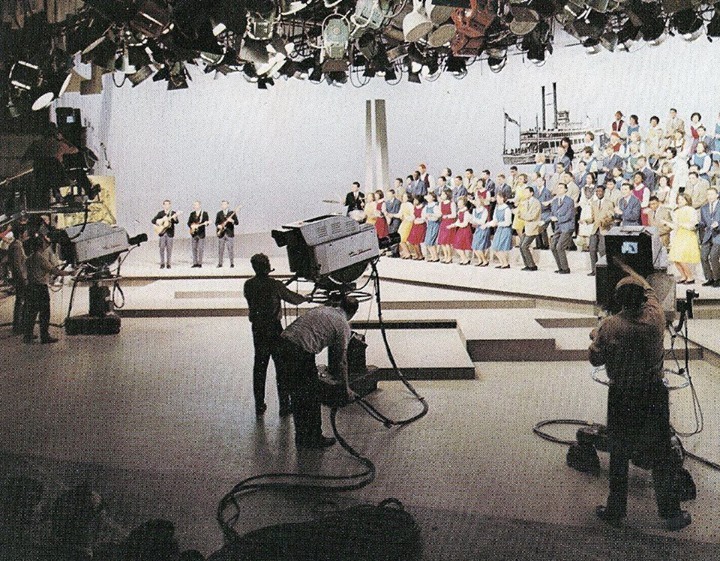

The History Of The Ampex Owned…Video Tape Center, Part 3 of 3
The History Of The Ampex Owned…Video Tape Center, Part 3 of 3
America’s First Commercial Television Production Facility
A few years ago, our friend Tom Coughlin traveled to Minnesota to comb the 3M archives as part of his ongoing research into the history of America’s first, and most innovative commercial tele production facility. Tom is a professor or journalism, but his deep interest here is also personal as his dad was a longtime staff member at Videotape Center as well. This is the final chapter of three fascinating installments. -Bobby Ellerbee
______________________________________________________
In order to free up space on the loading dock (which also doubled as a parking spot for the remote truck) between January and April 1967, the TK-41c cameras were taken off the truck and installed temporarily at Videotape Center while the Norelco cameras were being installed. Studio A had three Norelcos running in April, and Studio B’s cameras arrived in May. By May 15, 1967, the RCAs were back on the truck and ready for sale to ABC–despite M-G-M not actually owning, but only leasing the contained equipment, and having to make monthly payments to RCA through to 1969.
The minutes of the board meetings from the 1965-1967 time period provide an interesting snapshot of the independent video production industry at the time. Reeves was heavily promoting their video pod production system to advertising agencies and film production houses for one-off TV shoots on video. According to a report from Engineering Director Don Collins to the board (meeting minutes from July 1966), while NBC and ABC owned remote trucks, CBS did not. Reeves Sound Services owned six Ampex 2000 (color, high-band) videotape recorders and two plumbicon cameras with three more on order. Reeves used Norelco cameras that were impeccably maintained, but the remotely recorded video frequently had dropouts and poor signal quality, also there were complaints of communication problems between the set and the tape room. For much of second half of 1966 while Videotape Center was upgrading the tape room, they had no high-band recording or color tape editing capability and used Reeves’ video services extensively.
Other competitors included Tele-tape, which had leased the Little Theater to produce the Merv Griffin Show for Group W, and was in the process of leasing a former CBS studio at 81st St. and Broadway. Tele-tape was based in Chicago, and had recently taken over Jam Handy (an industrial film production company), a merger that was more expensive and less lucrative than they had anticipated. They had 90 people working in New York, 17 in Chicago, owned seven videotape machines and had six more on order. Lewron, a Baltimore-based company, had purchased a building in New York City and was slowly building it out as a TV studio. On the West Coast (Videotape Center had a Los Angeles office and was ready to send the Leo truck to the coast if work calls came) Technicolor had a two camera video truck.
The engineering department had taken over the operation of Telestudios “TVola” editing system which was offered to the public in 1966, which offered offline editing using a 16mm film kinescope with videotape timecoding applied.
Clients from the 1965-67 time frame include: ABC, who leased Studio C to shoot the soap opera, “The Nurses”, and had rented studio space for “Campy’s Place” and the “Jimmy Dean Show”.
During the 1966-1967 television season, Videotape Center’s tape room edited and duplicated “Password” for syndication (the show was produced at CBS in Hollywood). Thirty to forty percent of the tape room’s post-production work was being shot elsewhere. TV specials produced at Videotape during that time period include “St. Joan” (a Hallmark Hall of Fame production that aired on NBC), “An Enemy of the People” (an NET Playhouse production for public television), and “A Case of Libel” a TV production of a popular Broadway show, produced by David Susskind that aired on ABC. For TV commercial work, Videotape employed two staff directors, Hal Stone, and Adrian Riso, and commercials produced during that time period included spots for S&H Green Stamps, National Airlines, Gillette, Arnold Bread, Tang, Stridex, Goodyear Tire, Dutch Masters Cigars, Johnson and Johnson Petroleum Jelly, Papermaid Products, and Xerox.
Equipment purchases during this timeframe include an Ampex VR-3000 (compact 2” videotape recorder) for use on the Leo truck during times when the videotape truck was leased to a different client. In June 1967, they purchased a HS-100 disc recorder to do slow motion and freeze frames in the tape room. Also the last remaining RCA TK-60 black and white camera, which was being used for slates, countdowns and superimpositions, was replaced with an Ampex BC-300.
In March 1967, ABC’s cancellation of “The Nurses” precipitated a cash flow crisis, and the management decided to close Studio C indefinitely, and look into the possibility of renting the space out to Fordham and Columbia University, who at the time wanted to move into the Lincoln Center neighborhood.
3-M’s board designee John B. Lanigan motioned in 1967 that the board of directors should give RKO the three-year advance notification that was required in their lease of W. 67th St. in order to shut down Videotape Center. He cited a number of reasons—the mission of the company (to popularize the use of video tape for TV commercial production) had largely been fulfilled; Videotape Center was consistently being outbid by other companies (Tele-tape and Reeves, principally), and had higher expenses than it’s competitors.
Also cited–the cultural differences between the 3-M and M-G-M directors, and what they considered acceptable business practices.
To run-out the final three years of the RKO studio lease as well as to liquidate the equipment assets, Lanigan negotiated with Avertel, a Toronto-based video tape house run by Ormand Collier, and Reeves Sound Services, who had offered $5 million to take over the business. Also Western Video Industries, a production studio based in a former NBC studio at Hollywood and Vine in Los Angeles (that coincidentally owned three stages and a remote truck) had also expressed interest in Videotape Center. The final proposed sale agreement was negotiated in the later part of 1968, with Avertel and Reeves both counter offering and bidding against each other. On November 11, 1968, Harold Reeves announced that Reeves agreed to purchase all the outstanding Videotape Productions stock from MGM and 3-M for an undisclosed price. With the deal, Reeves had acquired two television studios worth of production equipment, and a lease on a building that would run out in Summer 1970.
It appears that the Leo remote truck, at the time on lease to ABC, was not included in the deal, and in March 1968 both M-G-M and 3-M were contacted by RCA who expressed concern that the sale of Videotape Center would create a situation of increased possibility of default on the lease payments. Lanigan’s response to the situation was to alert the M-G-M directors of RCA’s concerns, and subsequently contact RCA and ask for their assistance in selling the equipment (presumably to ABC). Under Reeves ownership, the facility continued to operate, doing business both as Videotape Center, and Reeves Lincoln Square Studios. In April, 1970, Broadcasting Magazine (p 104) announced that ABC was negotiating to purchase the Reeves facility at 101 West 67th St. for approximately $3 million in cash. According to the article, the sale included a substantial part of the equipment that was installed there, and the deal was expected to close during the month subject to the approval of the ABC board of directors. Over the summer of 1970, the ABC signs went up on the building—from then on the facility was known as TV-18/19.
Shown here, the VTC TK41s shooting an “Up With People” special, the 67th Street property as ABC’s TV 18/19 and a Westinghouse commercial shoot with Betty Ferness.
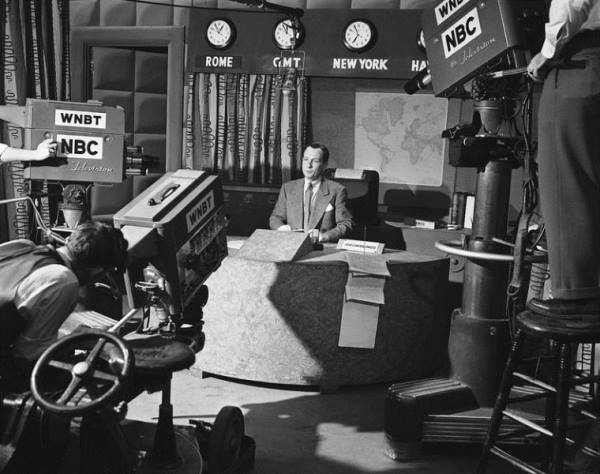

February 16, 1949…A Red Letter Day In NBC News History
February 16, 1949…A Red Letter Day In NBC News History
The most widely celebrated dates in NBC news history are February 16, 1948 and February 16, 1949. In ’48 “The Camel Newsreel Theater” debuted as a 10 minute weeknight newsreel. The film was provided by Fox Movietone News and was narrated off camera by NBC Radio’s John Cameron Swayze.
On February 16, 1949, Swayze moved in front of the camera and that began “The Camel News Caravan” as a live 15 minute weeknight news show, some 10 months after CBS had put Douglas Edwards on camera May 3, 1948.
BUT…this was not the start of news at NBC. In fact, almost immediately after their first regular TV service began April 30, 1939, news had begun to be reported on W2XBS (WNBT).
Newscaster Lowell Thomas had occasionally simulcast his NBC Radio show locally from Studio 3H as early as December 1939 and from February till July of 1940, he regularly simulcast his “Sunoco News” show to New York viewers.
There was also the weekly, live “Esso Television Reporter” from March until May of 1940 hosted by William Spargrove, who narrated off camera. The live Esso program used organ music and on camera was a mix of newswire photos, maps and graphic miniature depictions of news event locations, as on-the-scene film reports were nearly impossible to get because no one had TV news departments.
Although the USA was not involved in WW II yet, Europe was fully engulfed in 1940. As we will see, the war severely curtailed television in every way, but there is more to the pre war story.
From July of 1941 till May of 1942, Sam Cuff hosted a weekly news commentary called “Face The War”, but the show ended as RCA and NBC cut television operations down to next to nothing five months after Pearl Harbor. The same was true at CBS.
On February 21, 1944, things started to stir a bit as “The War As It Happens” came to television on a weekly basis, and NBC News has been on the air more-or-less continuously since then.
“The War As It Happens” began as a local program, but NBC records indicate that in April of 1944, it was fed to Schenectady and Philadelphia on the fledgling NBC Television Network and became the first news cast regularly seen in multiple cities.
At the time, even the great NBC Radio news department was tiny compared to the wire services and newspapers and newsreels. Television was even less able to gather news because they didn’t even have local film crews. The first breakthrough came in 1944 when John Royal, the first head of television at NBC, acquired the rights to Army Signal Corps film.
Using this footage, “The War As It Happens” followed what was basically a newsreel format, using the film with Paul Alley narrating and Ray Forrest in the studio with commentary, maps and wire photos.
In August 1945, the war was over and the Sunday “The War As It Happens” newscast was renamed “The NBC Television Newsreel”.
In mid 1946, it gained a sponsor and became “The Esso Newsreel” and was rescheduled to two nights a week, Monday and Thursday.
On February 16, 1948 Esso bowed out and a new sponsor came to the show which became “The Camel Newsreel Theater”.
In December of ’48, NBC took over an 11 story Pathe studio building at the Pathe complex at 106th Street and this was the start of NBC’s Uptown Studios. The complex included Pathe’s labs and this was a big plus for NBC in many ways.
R.J. Reynolds, makers of Camel cigarettes, was ready to spend big money on a news show and had CBS and NBC competing for the account. They wanted as much film from as many places as possible, and Camel chose NBC because of the network of staff photographers Paul Alley had put together for “NBC Television Newsreel”.
NBC had 4 film cameramen in New York, 2 in Washington, one in Florida and stingers around the country with 38 cameras, 18 mobile units and 16 reporters. AND, through Pathe, NBC had immediate access to film from around the world.
Camel paid NBC $2,600 per program, compared to the $1,000 CBS got for their Oldsmobile sponsored show. This money from Camel changed TV news in a big way and supported the entire world wide structure of NBC News.
“The Camel News Caravan” was broadcast live each weeknight from 7:45 -8 PM from Studio C at NBC’s Uptown Studios, with the film being projected from Studio F in that building.
Around 1952, Caravan moved to a small 3rd floor studio at 30 Rock, and from that year, here is an entire edition of Caravan from September 19, 1952…just days before Vice President Richard Nixon’s famous “Checkers” speech. As you see, the story is starting to break. By the way, behind the books at the corner of Swayze’s desk, there is a red light that signals when he should narrate over the film.
Also included here is NBC’s January 1949 press release on the new news show. Notice the stations that were aboard the network at the bottom of page two.
In 1956, Swayze was replaced by Chet Huntley and David Brinkley. I think you know the rest of the story, but here is NBC’s tribute to their news heritage on the 60th Anniversary.
P.S. The Origins Of Television News In America by our friend Mike Conway at Indiana University is the best book on early television news I have ever read! -Bobby Ellerbee


February 15, 1958…Dick Clark Goes Primetime From New York
February 15, 1958…Dick Clark Goes Primetime From New York
59 years ago today, “Dick Clark’s Saturday Night Beechnut Show” debuted on ABC, live from The Little Theater at 234 West 44th Street. These two videos will give us a good look inside and outside the 300 seat venue, but first a bit of history.
To make sure there was an audience for the show, ABC did a 13 week primetime test of “American Bandstand” from Philadelphia that lasted from October 7 till December 16, 1957. The ratings for the half hour show were good, but Clark and others came to the conclusion that the primetime version need more stars and less dancing to records.
In ’57, ABC had leased The Little Theater for their new show with Johnny Carson as host of “Do You Trust Your Wife”, which soon became “Who Do You Trust”. It was available weekends and the NYC teens wanted a show like this, so that’s where it was done using at least two artist per half hour show, and sometime three. The show ran weekly for almost three years on Saturday nights as Bandstand continued weekdays from Philly.
Very few performances were done live, but in this clip with Jerry Lee Lewis doing “Great Balls Of Fire”, it is live. This starts in the lobby with “Short Shorts” and the The Royal Teens bop their way to the stage. The glass booth behind them is the audio booth.
In the Conway Twitty clip below, we get the full show intro from Dick outside the theater as Conway starts in the lobby and moves to the stage. The glass booth behind him is the video control room. Who knew that Sarid’s was next door? Enjoy! -Bobby Ellerbee
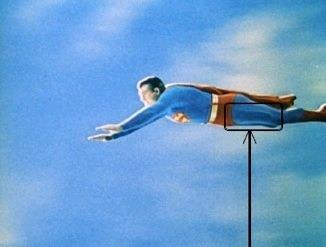

How Superman “Flew”
Below, is Superman’s “flying pan” which was used by George Reeves in “The Adventures Of Superman”, that many of us grew up watching. After a few falls from wire suspension, one which was fairly serious, the pan was developed for Reeves to lay in and the tilting and rolling action was controlled by a long lever.
In this clip, Noel Neil (who played Lois Lane) talks about the flaying pan and some of the problems Reeves had “flying”.
On the top image, if you look at his leg, you can see it under his suit. Also shown is a drawing of the device in use and a shot of that actual body pan which is now in the Superman Museum in, wait for it…Metropolis, Illinois. Enjoy and Share! -Bobby Ellerbee


The Untold Story Of The “John And Marsha” Commercials
The Untold Story Of The “John And Marsha” Commercials
In the mid ’50s, this commercial campaign (video) was the equivalent of the 1984 “Where’s The Beef” campaign from Wendy’s. All of us old enough to have seen it still remember this Snowdrift Shortening commercial from our childhood, others may remember it from seeing it used in ‘Mad Men’, but I’ll bet NONE of us knew THIS!
Play this video and you will be very surprised! Go ahead…do in now.
Surprised? Me too! I had no idea the the award winning commercial from 1956 was based on Stan Freberg’s 1951 novelty hit, but it was.
The February 10, 1951 release, “John and Marsha” was a soap opera parody that consisted of the title characters (both played by Freberg) doing nothing but repeating each other’s names with intonations to match the moods. It never was a big hit, but did get a lot radio airplay and obviously left a lasting impression.
Producer/Director John Hubley and Animator/Artist Art Babbitt were given the New York Art Directors Award for Best Animated Short for the spot in June of 1956. I still remember all of the words…you too? Enjoy and share! – Bobby Ellerbee
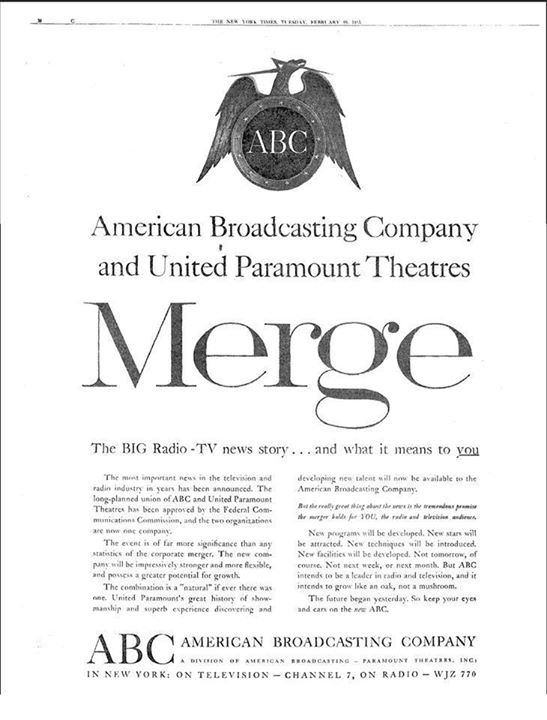

February 9, 1953…ABC Is Born Again With A Mega Merger
February 9, 1953…ABC Is Born Again With A Mega Merger
That was the day United Paramount, led by Leonard Goldenson, came to the rescue and saved the company from bankruptcy.
On October 12, 1943, Edward John Noble, the owner of Life Savers candy, and the radio station WMCA in New York, bought NBC’s Blue Network for $8 million.
This was the start of ABC, but even with Noble’s millions, the first 10 years was a hard slog financially. The one thing ABC did that would later made the struggling network so appealing to a new buyer was something done on a whim, that cost them nothing.
Without asking Nobles, ABC’s chief engineer had applied to the FCC for Construction Permits for 5 television licenses, all on Channel 7, in New York, Chicago, San Francisco, Los Angeles and Detroit. Shortly after, the FCC froze license applications due to an overwhelming crush of requests. The next part, putting these stations on the air would cost big money, and that is where the financial squeeze got serious. That was 1948.
In much the same way NBC was forced to sell the Blue Network,
the movie theater operator United Paramount Theaters (UPT) was forced to become an independent entity, separating itself from the film studio Paramount Pictures in 1949.
For its part, ABC was on the verge of bankruptcy, and in 1951, Noble borrowed $5 million from the Prudential Insurance Company to save the company…at least for the time being.
Leonard Goldenson, the president of UPT, approached Noble in 1951 and proposed that UPT purchase ABC. Noble received further offers, including one from Bill Paley of CBS. Goldenson and Noble reached a tentative agreement in the late spring of 1951 that ABC would become a subsidiary of UPT, but would remain autonomous in its management.
On June 6, 1951, UPT’s board of directors validated their tentative agreement. However, the transaction had to be approved by the FCC. Insofar as the Paramount Pictures film studio was already a shareholder of the DuMont Television Network, the FCC conducted a series of hearings to ensure whether Paramount was truly separated from United Paramount Theaters, and whether it was violating antitrust laws.
In 1952, when the FCC ended its freeze on applications for new stations, among the issues to be addressed was the approval of the merger between UPT and ABC.
On February 9, 1953, the FCC authorized UPT’s purchase of ABC in exchange for $25 million in shares, and the company was renamed American Broadcasting-Paramount Theaters, Inc.
The new company was based in Paramount’s headquarters at 1501 Broadway in New York, and owned six AM radio stations, several FMs, as well as five TV stations and 644 cinemas in 300 cities throughout the United States.
In consideration of this merger, UPT sold its television station in Chicago, WBKB-TV, to CBS for $6 million. CBS changed the calls to WBBM-TV. They kept ABC’s existing Chicago station, WENR-TV but moved the WBKB call letters to channel 7, which would eventually become WLS-TV. Goldenson began to sell some of the old theaters to finance the new television network.
On May 1, 1953, ABC’s flagship stations – WJZ, WJZ-FM and WJZ-TV in New York – adopted the callsigns of WABC, WABC-FM and WABC-TV, and moved to 7 West 66th Street, one block from Central Park.
At the same time, Goldenson had been trying to convince his movie studio friends to provide content for the network. ABC’s merger with UPT led to the creation of relationships with Hollywood’s film production studios, breaking a long quarantine that had existed between film and television.
Goldenson’s efforts paid off, and on October 27, 1954, the network was able to launch a “New ABC” campaign with the productions of several studios, including Metro-Goldwyn-Mayer, Warner Bros., and 20th Century Fox. This was the start of the TV westerns.
Before that though, the most iconic (and ironic) of ABC’s relationships with Hollywood producers was its agreement with Walt Disney. Walt and his brother Roy contacted Goldenson at the end of 1953 to ask ABC to finance part of the Disneyland project in exchange for Disney’s production of a television series.
Walt wanted ABC to invest $500,000 and a guarantee of $4.5 million in additional loans, a third of the budget intended for the park. Around 1954, ABC agreed to finance Disneyland in exchange for the broadcasting of a new television program, “Disneyland”, which debuted on the ABC network on October 27, 1954, as the first of many anthology TV programs that Disney would broadcast over the course of the next fifty years. We all know the rest of the story! Enjoy and share! -Bobby Ellerbee
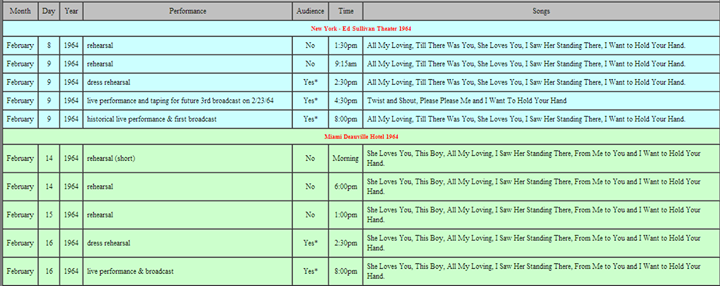

February 8, 1964…The Beatles & Ed Sullivan Prepare To Make History
February 8, 1964…The Beatles & Ed Sullivan Prepare To Make History
On this date in 1964, The Beatles had their first rehearsal for “The Ed Sullivan Show” at CBS Studio 50 in New York. All prior highs in television ratings and record sales was about to explode.
Many still haven’t realized that The Beatles third appearance on “The Ed Sullivan Show” on February, 23 1964 was taped the afternoon of their first live appearance on February 9th. This time table is a great help in understanding the sequence of events that began on this day in 1964.
Some may wonder how the Saturday rehearsal was possible since “The Jackie Gleason Show” was also done at Studio 50 on Saturdays, and the answer may surprise you. Beginning around 1961, Gleason began taping the show on Thursday nights, but it was live-to-tape with no edits, which kept the show looking as live as it had since it’s start in 1952. Enjoy and share! -Bobby Ellerbee
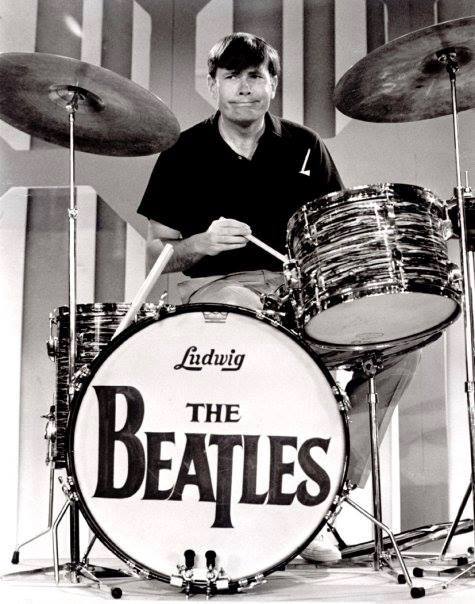 Above is one of the world’s most unique selfies…Sullivan Assistant Director John Moffit (without his glasses) at Ringo’s black oyster pearl Ludwig drums, just after the Saturday morning rehearsal. The next two photos are from the two Sunday rehearsals and the tall man with the glasses is Moffit and the shorter bald man is Director Tim Kiley.
Above is one of the world’s most unique selfies…Sullivan Assistant Director John Moffit (without his glasses) at Ringo’s black oyster pearl Ludwig drums, just after the Saturday morning rehearsal. The next two photos are from the two Sunday rehearsals and the tall man with the glasses is Moffit and the shorter bald man is Director Tim Kiley.
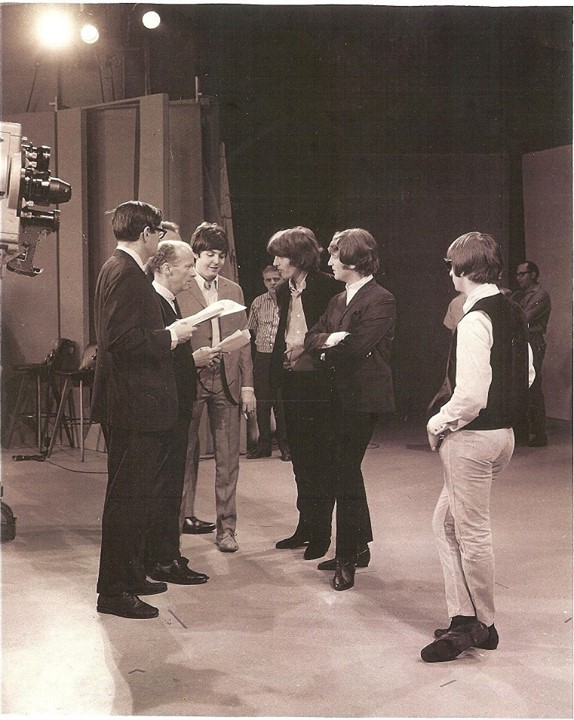


Producer Joseph Cates…The Man Who Introduced Ralph To Norton
Producer Joseph Cates…The Man Who Introduced Ralph To Norton
A few years back, I was fortunate meet actor Kevin Kline, and of all things, we talked mostly about television history…and you will not believe his connection to a True Pioneer!
In case you had forgotten, Kevin is married to actress Phoebe Cates, whose father was Joseph Cates. His younger brother was Gil Cates who is probably the top awards show producer of all time. Here’s Joe’s incredible story Kevin told, history I had never known about.
In 1949, Joe Cates was an associate producer on Dumont’s new “Cavalcade Of Stars” show. When he started, Jack Carter was the host, but soon, Jerry Lester took over. In June of 1950, Lester left to host NBC’s “Broadway Open House” which opened the door to a comedian new to live television. His name was Jackie Gleason.
Morey Amsterdam also had a show on Dumont which was set in the imaginary Silver Swan Cafe nightclub. Morey was the club owner and his head waiter, named Newton, was played by Art Carney.
Although “The Honeymooners” was still a year away, Jackie and Joe had been talking about the sketch idea for a while and it was Joe Cates that introduced Gleason to Art Carney.
Even before “The Honeymooners’ sketches began, Cates had thought Art would be a good “second banana” and foil to Gleason in other Cavalcade sketches, which he was. When Amsterdam’s show was canceled in October 1950, Gleason hired Carney.
According to Kevin, “The Honeymooners” set is a combination of Joe’s apartment, where he and Jackie often met for drinks and planning sessions, and of Gleason’s childhood apartment.
Although Cates wanted to work with Gleason, Joe was made the producer of two other shows…”Buck Rogers”, and “The Sammy Kaye Show”.
In 1955, Joe became the executive producer for “The $64,000 Question”. He’s the one that decided to use an actor (Hal March) as a host instead of a broadcaster to add to the drama. But, let’s backtrack to the days before “Cavalcade of Stars”.
While working in advertising after the war Cates got the idea of using television to sell candy, and signed a contract with Dumont to produce a high-school talent search program he called “Look Upon a Star” with Bess Myerson, the 1945 Miss America, as host. Operating on a $100 budget, limited to two cameras and facing the unforgiving pace of live television, Mr. Cates managed to pull it off and emerged as one of the more experienced and skilled variety-show production specialists in a fledgling medium.
While working at Dumont with Gleason and Carney on “The Cavalcade of Stars” he also worked on “The Cavalcade of Bands”, which set off a deep interest in music specials as well as comedy which lead him to NBC to produce the “Bob and Ray” show.
His network experience helped lay the groundwork for his later career as an independent producer, which included a succession of specials with Alan King, Robert Klein, Steve Martin and other comedians, a string of David Copperfield magic shows and a number of musical specials for Gene Kelly, Ethel Merman, Victor Borge, Perry Como, Andy Williams, Nat King Cole and others.
By his own estimate, from the live high school talent program he staged for the old Dumont network in the late 1940’s to his string of fund-raising specials for Ford’s Theater in Washington, Mr. Cates wrote, directed and produced more than 1,000 television productions.
Joseph Cates, was born Joseph Katz, but interestingly, this native New Yorker was infatuated with country music and did dozens of country music specials, produced with the help of his friend Johnny Cash. Those shows, which used sophisticated lighting and other softening techniques, were credited with making country music acceptable for a mass medium. The country music industry was so grateful that Mr. Cates became the only producer honored by the Country Music Hall of Fame.
Below is Ann Francis with Joseph Cates on the set of one of several movies he directed. This is “Girl Of The Night” from 1960 which dealt with the life of a call girl…quite a taboo subject at the time, but this inspired Elizabeth Taylor to take on a similar role in “Butterfield 8”. -Bobby Ellerbee
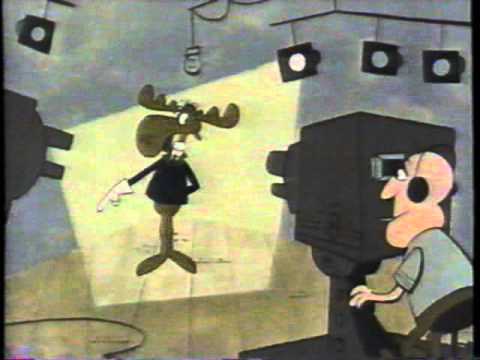
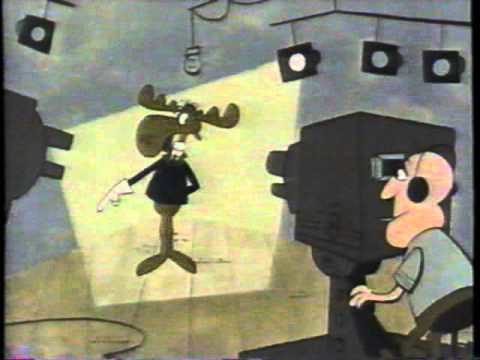
An Hour With Rocky & Bullwinkle…The Whys, Hows & Whos Of The Show
An Hour With Rocky & Bullwinkle…The Whys, Hows & Whos Of The Show
The Wayback Machine is set for 1963 and everybody is here! On top of tons of cartoon footage, we meet the voices, writers and masterminds – Bill Scott and Jay Ward – of the most beloved TV cartoon characters of our generation.
Rocky, Bullwinkle, Dudley, Nell, Snidely, Mr. Peabody, Sherman, Boris, Natasha, the Fractured Fairy Tales, the inside jokes, fun with the censors, and even a real life story involving President Kennedy and the Cuban Missile Crisis are all part of this trip down memory lane. Enjoy and share! -Bobby Ellerbee
Behind the scenes of the greatest animated cartoon series ever created.


Meet The Voice Of The “Law & Order” Franchise…Steve Zirnkilton
Meet The Voice Of The “Law & Order” Franchise…Steve Zirnkilton
How many times have you heard “In the criminal justice system”, and wondered just who that great voice belongs to? Well the answer is Steve Zirnkilton.
There are a lot of stories about how he happened to get the job, but here is his version, as told to Backstage Magazine in 2014.
“As it happened, Dick Wolf was buying a house up here in Maine, and at that time, I had my real estate brokers license and my insurance license. I approached him and asked if I could act as his buyer’s representative to make sure that everything would go smoothly.
When the transaction was complete he said, “What do I owe you?” I immediately passed him a cassette tape which was my VO demo. I handed it to him and he wasn’t quite sure what to do with it. I didn’t hear anything and then some months later, his secretary called saying that he wanted me to do the bumpers for a show called “Nasty Boys,” a spring launch for NBC.
That lasted about six episodes. I figured I’d had my shot. Then I got a call from Mr. Wolf’s secretary saying that Mr. Wolf has a show called “Law & Order,” and he’d like you to play a detective in the show. I played a detective in the pilot and shared a trailer with William H. Macy.
Nobody wanted the show. CBS and Fox both passed. Nearly a year went by and then Brandon Tartikoff at NBC decided to give it a try. Mr. Wolf’s secretary called me again and said, “Please meet Mr. Wolf at the recording studio. He has something he’d like you to read.” And that was the opening. I had no idea if the show would have any legs, but happily it hung around for a while.”
For uniformity’s sake, Dick Wolf has used his voice on all of the other Law & Order shows and Zirnkilton is the only person, other than Wolf, to appear in the credits for every episode of every show. Although the pilot episode of “Law & Order” did not have the voice over opening, he got screen credit for his role as an on camera detective. Since then, he has been listed as the narrator.
If his residuals are anything like what Paul Anka and Johnny Carson split for their authorship of Johnny’s “Tonight Show” theme, this is one very fat cat! Well done Steve! -Bobby Ellerbee
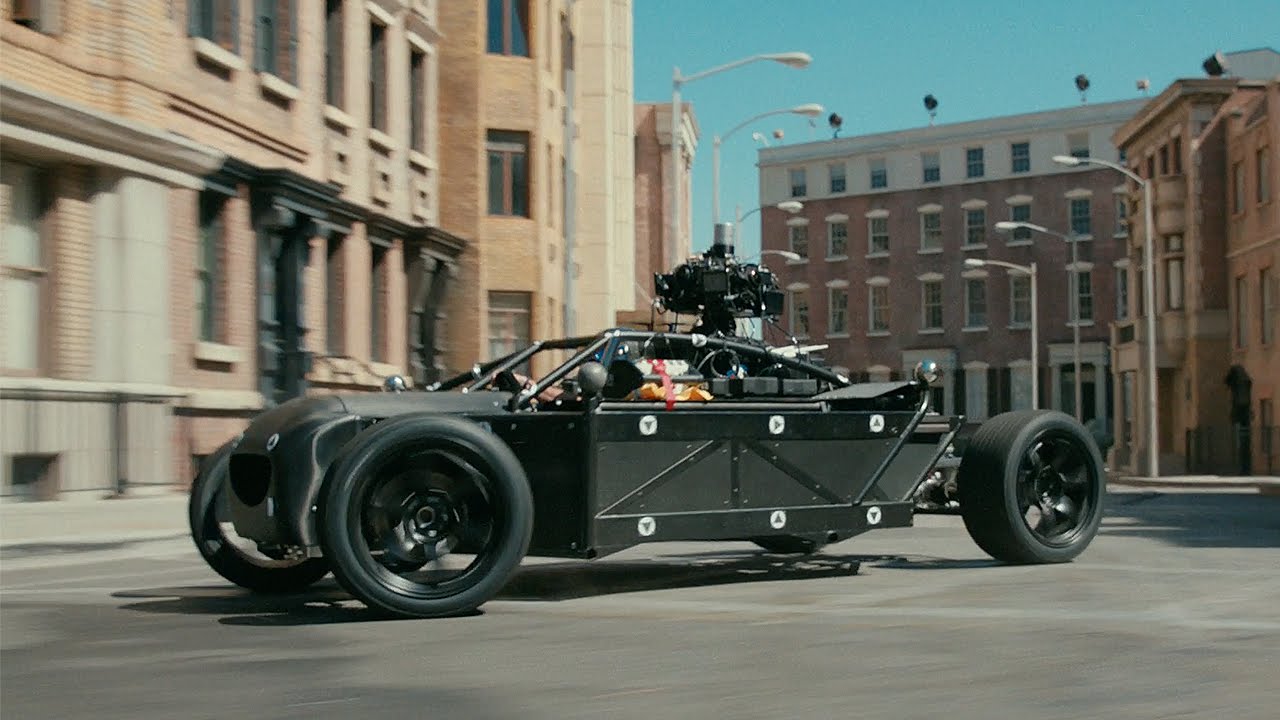
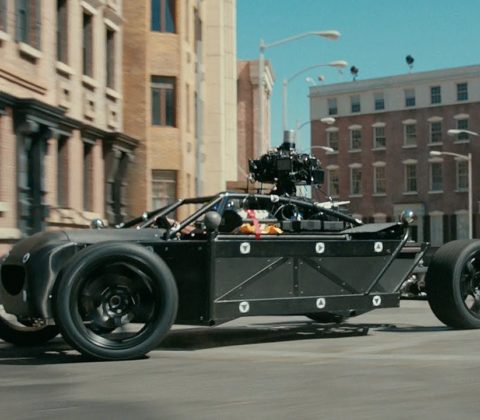
Meet “Blackbird”…Via CGI, It Is Any Car You Want It To Be (2 Videos)
Meet “Blackbird”…Via CGI, It Is Any Car You Want It To Be (2 Videos)
Had this technology been available in the ’60s, George Barris would never have had to build the Batmobile, the Munster’s car or the Beverly Hillbillies truck, because this car can become any car!
Here’s a short video that shows how adding a “skin” or real car look works.
In essence, the Blackbird is a mobile camera rig designed to morph into any car in the world. At the push of a button the fully adjustable chassis can modify its length by 4 feet and width by 10 inches. It can fit any wheel set and be altered for any type of suspension and chassis design. You can see all this and more demonstrated in the second video below.
Two years in development, the Blackbird was hand built by the world’s top technicians from JemFX in the same hangar that the Blackbird SR-71 supersonic jet was once manufactured. The car rig’s name is a nod to this legacy of stealth design.
Although this is very cool, so is seeing the original Batmobile in person. These days, its hard to believe your own eyes. -Bobby Ellerbee
Special effects company The Mill has come up with a technology so intriguing, we just had to give it a go. Meet the ‘Blackbird’, which is all about taking mo…
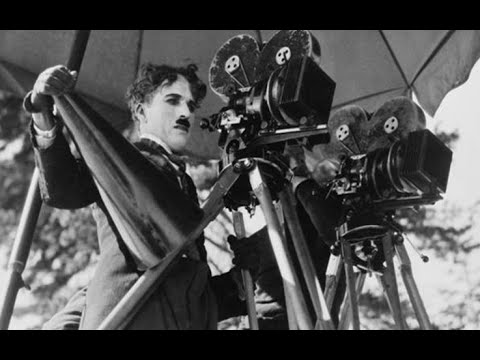
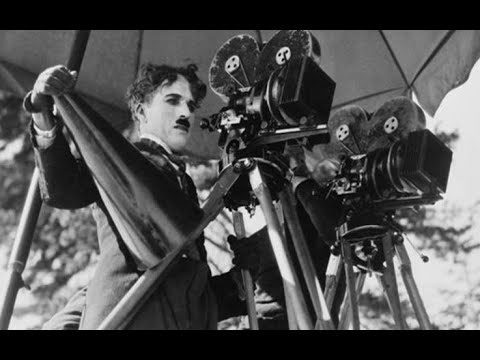
The Chaplin Studios…A Mega Magical Place In Time
The Chaplin Studios…A Mega Magical Place In Time
It is hard to know where to start, because we have a rare opportunity to see this historic landmark as is is now, and as it was when it was first built at 1416 N. La Brea Avenue in Hollywood.
I’ve written a short history here which comes to life in these three videos.
In 1919, construction was completed on the land bought in 1917 by silent screen icon Charlie Chaplin, including his personal residence on the site. Many of Chaplin’s classic films were shot at the studios, including “The Kid” (1921), “The Gold Rush” (1925), “City Lights” (1931), “Modern Times” (1936), “The Great Dictator” (1940), “Monsieur Verdoux” (1947), and “Limelight” (1952).
This remarkable video shows the studio site in 1917, when it was just an orange grove and includes a rare time lapse of the studio being built. It continues with Chaplin “making a movie” which gives us a look at almost every part of the lot, including his office, the sound stage, The Barn, film lab and much more…even Fatty Arbuckle plays a part. This is fascinating!!
For comparison, here is a recent tourist video that kind of gushes, but is none the less quite detailed and shows us some things verified in the first video, like the door Charlie used, which is not a door anymore.
In that in the tourist video we didn’t see inside the sound stage, here is a KABC story on the property from a few years back that takes is inside.
Now…back to our history.
In 1953, a New York real estate investor bought the studio from Chaplin, who had left America permanently in October 1952. The new owner had planned to tear down the studio, but instead, leased it to a television production company and it became known as Kling Studios. This is where the first couple of years of “The Adventures Of Superman” were shot. When the series went from B/W to color, the production moved.
In 1959, Red Skelton began producing his CBS television series at the facility, and in April 1960 Skelton purchased the studio. Skelton also purchased three large mobile units for taping color television shows, making a total investment estimated at $3.5 million. Skelton had a large “Skelton Studios” sign erected over the main gate on La Brea Avenue. Here is an article on the Skelton Studios color mobile unit on page 18.
http://www.americanradiohistory.com/Archive-RCA-Broadcast-News/RCA-110.pdf
Skelton sold the studio to CBS in 1962, and CBS shot the Perry Mason television series there from 1962–1966.
In 1966, Herb Alpert and Jerry Moss purchased the studio from CBS to serve as a headquarters for A&M Records.
In 1985, the hit single and video “We Are the World” was recorded in A&M’s Studio A.
From 1981 to 1985, Soul Train taped at The Chaplin Stage.
In February 2000, Jim Henson’s children purchased the studio for $12.5 million to serve as the new home of The Jim Henson Company.
There is a lot here to take in, but I hope you will take the time to see all the attached video and read the articles. It is not often that you get a chance to really understand the history of such important places, and this is one indeed sacred ground in the world of entertainment. There is more at the links below.
http://patch.com/california/echopark/historic-chaplin-studio-still-stands-in-hollywood-e7630558
http://dearoldhollywood.blogspot.com/2009/02/chaplin-studios.html
